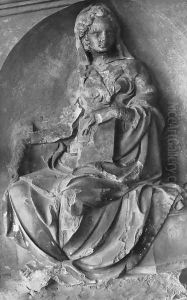Jacopo della Quercia Paintings
Jacopo della Quercia, born around 1374 in Siena, Italy, was a pivotal figure in the early Renaissance, marking a significant transition from the Gothic to the Renaissance style in sculpture. His work, characterized by a robust and dynamic approach to form and an exceptional understanding of the human anatomy, had a profound influence on the development of Renaissance art, bridging the gap between the Gothic tradition and the innovations of the Renaissance.
Jacopo's early life is somewhat obscure, but it is known that he was the son of a craftsman and that he began his artistic career in Siena. His early works, including the relief sculptures for the Fonte Gaia (Fountain of Joy) in Siena's Piazza del Campo, already showcased his talent for combining detailed narrative with expressive figures, setting him apart from his contemporaries.
In 1401, Jacopo participated in the famous competition for the second set of bronze doors for the Florence Baptistery, a contest that also involved Lorenzo Ghiberti and Filippo Brunelleschi. Although Ghiberti won, the competition was a crucial moment in Italian art history, highlighting the emerging talents of the early Renaissance.
One of Jacopo's most celebrated works is the portal of San Petronio Basilica in Bologna, which he began in 1425. The reliefs on the portal display a mastery of human emotion and a dramatic sense of movement, qualities that would influence later Renaissance artists, including Michelangelo, who is said to have been inspired by Jacopo's work.
Jacopo della Quercia's contributions to art were not limited to sculpture. He also worked on architectural projects and was involved in the design of the Loggia della Mercanzia in Siena. His ability to infuse sculptures with a sense of life and his innovative use of space and form made him a key figure in the transition to the Renaissance style.
Jacopo della Quercia died in 1438, leaving behind a legacy that would inspire the next generation of artists. His work represents a crucial link between the Gothic traditions of the Middle Ages and the rebirth of classical ideals in the Renaissance. Through his innovative approach to sculpture, Jacopo played a significant role in shaping the course of Western art history.













